Organizational Change Management at Pilkington: A Business Report
VerifiedAdded on 2020/03/28
|12
|2800
|72
Report
AI Summary
This report provides a comprehensive analysis of the organizational change management strategies implemented at Pilkington, a renowned glass manufacturer. It explores the factors that necessitated change, including international competition, internal workforce demographics, and outdated practices. The report details the three phases of organizational restructuring, focusing on information flow, production processes, and international business structure adjustments. It also examines organizational culture problems, such as hierarchical structures and resistance to change from an older workforce. Furthermore, the report highlights the importance of employee motivation and addresses the challenges of resistance to change, including fear of the unknown and job security concerns. The report concludes by summarizing the implementation of changes, including the strategic phasing over two years and the adoption of bottom-up communication and team-based production. The report underscores the critical role of organizational change in adapting to a dynamic business environment, and provides valuable insights into the successful navigation of such transitions.
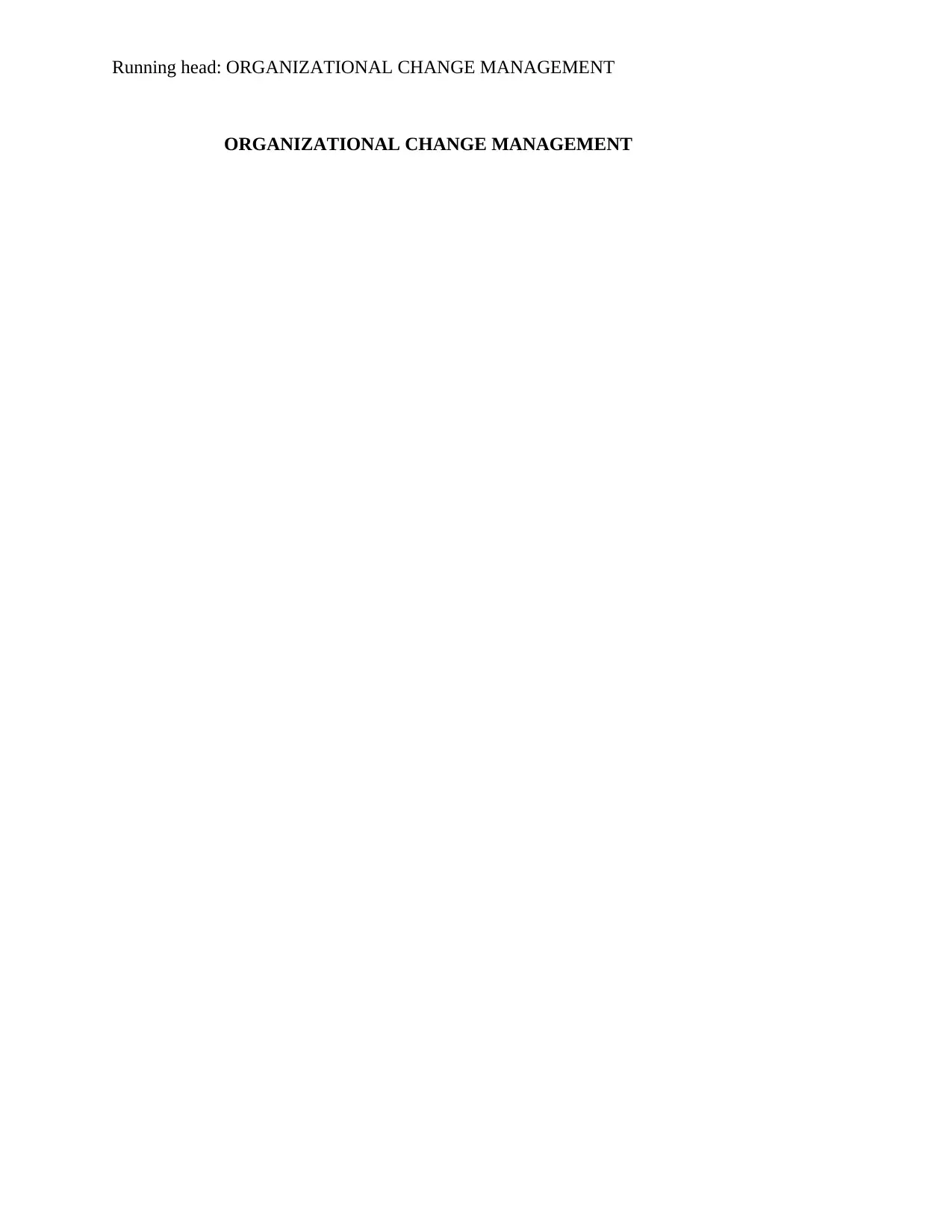
Running head: ORGANIZATIONAL CHANGE MANAGEMENT
ORGANIZATIONAL CHANGE MANAGEMENT
ORGANIZATIONAL CHANGE MANAGEMENT
Paraphrase This Document
Need a fresh take? Get an instant paraphrase of this document with our AI Paraphraser
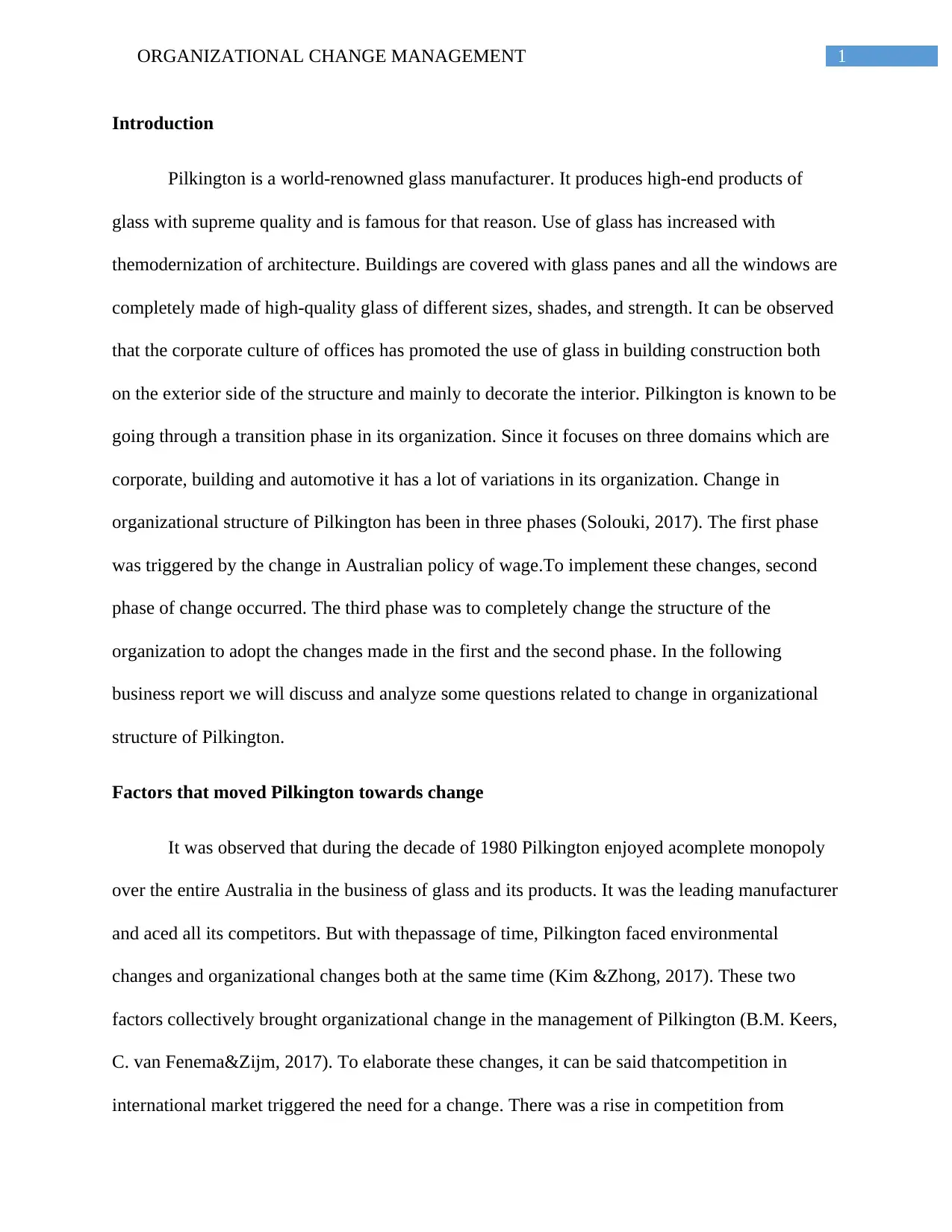
1ORGANIZATIONAL CHANGE MANAGEMENT
Introduction
Pilkington is a world-renowned glass manufacturer. It produces high-end products of
glass with supreme quality and is famous for that reason. Use of glass has increased with
themodernization of architecture. Buildings are covered with glass panes and all the windows are
completely made of high-quality glass of different sizes, shades, and strength. It can be observed
that the corporate culture of offices has promoted the use of glass in building construction both
on the exterior side of the structure and mainly to decorate the interior. Pilkington is known to be
going through a transition phase in its organization. Since it focuses on three domains which are
corporate, building and automotive it has a lot of variations in its organization. Change in
organizational structure of Pilkington has been in three phases (Solouki, 2017). The first phase
was triggered by the change in Australian policy of wage.To implement these changes, second
phase of change occurred. The third phase was to completely change the structure of the
organization to adopt the changes made in the first and the second phase. In the following
business report we will discuss and analyze some questions related to change in organizational
structure of Pilkington.
Factors that moved Pilkington towards change
It was observed that during the decade of 1980 Pilkington enjoyed acomplete monopoly
over the entire Australia in the business of glass and its products. It was the leading manufacturer
and aced all its competitors. But with thepassage of time, Pilkington faced environmental
changes and organizational changes both at the same time (Kim &Zhong, 2017). These two
factors collectively brought organizational change in the management of Pilkington (B.M. Keers,
C. van Fenema&Zijm, 2017). To elaborate these changes, it can be said thatcompetition in
international market triggered the need for a change. There was a rise in competition from
Introduction
Pilkington is a world-renowned glass manufacturer. It produces high-end products of
glass with supreme quality and is famous for that reason. Use of glass has increased with
themodernization of architecture. Buildings are covered with glass panes and all the windows are
completely made of high-quality glass of different sizes, shades, and strength. It can be observed
that the corporate culture of offices has promoted the use of glass in building construction both
on the exterior side of the structure and mainly to decorate the interior. Pilkington is known to be
going through a transition phase in its organization. Since it focuses on three domains which are
corporate, building and automotive it has a lot of variations in its organization. Change in
organizational structure of Pilkington has been in three phases (Solouki, 2017). The first phase
was triggered by the change in Australian policy of wage.To implement these changes, second
phase of change occurred. The third phase was to completely change the structure of the
organization to adopt the changes made in the first and the second phase. In the following
business report we will discuss and analyze some questions related to change in organizational
structure of Pilkington.
Factors that moved Pilkington towards change
It was observed that during the decade of 1980 Pilkington enjoyed acomplete monopoly
over the entire Australia in the business of glass and its products. It was the leading manufacturer
and aced all its competitors. But with thepassage of time, Pilkington faced environmental
changes and organizational changes both at the same time (Kim &Zhong, 2017). These two
factors collectively brought organizational change in the management of Pilkington (B.M. Keers,
C. van Fenema&Zijm, 2017). To elaborate these changes, it can be said thatcompetition in
international market triggered the need for a change. There was a rise in competition from
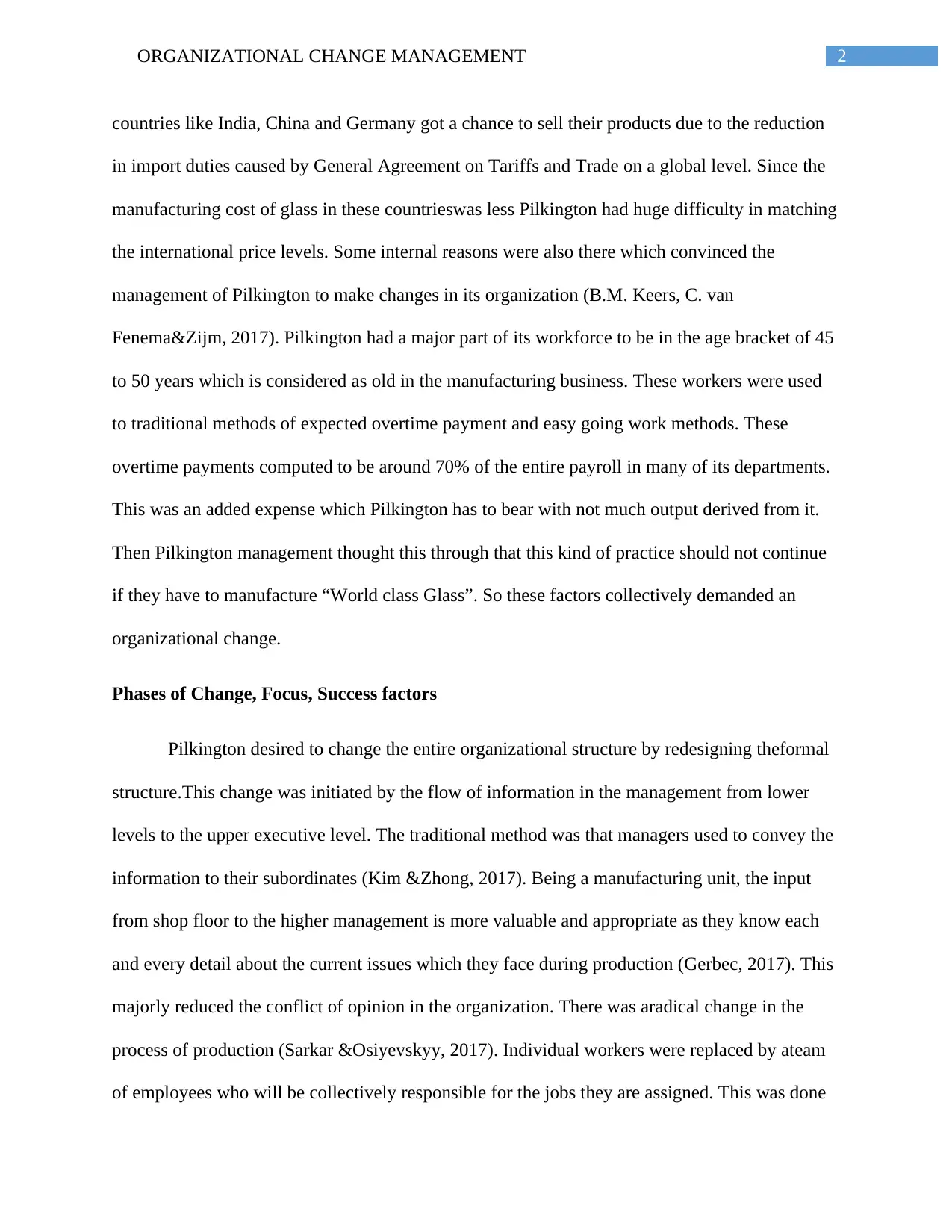
2ORGANIZATIONAL CHANGE MANAGEMENT
countries like India, China and Germany got a chance to sell their products due to the reduction
in import duties caused by General Agreement on Tariffs and Trade on a global level. Since the
manufacturing cost of glass in these countrieswas less Pilkington had huge difficulty in matching
the international price levels. Some internal reasons were also there which convinced the
management of Pilkington to make changes in its organization (B.M. Keers, C. van
Fenema&Zijm, 2017). Pilkington had a major part of its workforce to be in the age bracket of 45
to 50 years which is considered as old in the manufacturing business. These workers were used
to traditional methods of expected overtime payment and easy going work methods. These
overtime payments computed to be around 70% of the entire payroll in many of its departments.
This was an added expense which Pilkington has to bear with not much output derived from it.
Then Pilkington management thought this through that this kind of practice should not continue
if they have to manufacture “World class Glass”. So these factors collectively demanded an
organizational change.
Phases of Change, Focus, Success factors
Pilkington desired to change the entire organizational structure by redesigning theformal
structure.This change was initiated by the flow of information in the management from lower
levels to the upper executive level. The traditional method was that managers used to convey the
information to their subordinates (Kim &Zhong, 2017). Being a manufacturing unit, the input
from shop floor to the higher management is more valuable and appropriate as they know each
and every detail about the current issues which they face during production (Gerbec, 2017). This
majorly reduced the conflict of opinion in the organization. There was aradical change in the
process of production (Sarkar &Osiyevskyy, 2017). Individual workers were replaced by ateam
of employees who will be collectively responsible for the jobs they are assigned. This was done
countries like India, China and Germany got a chance to sell their products due to the reduction
in import duties caused by General Agreement on Tariffs and Trade on a global level. Since the
manufacturing cost of glass in these countrieswas less Pilkington had huge difficulty in matching
the international price levels. Some internal reasons were also there which convinced the
management of Pilkington to make changes in its organization (B.M. Keers, C. van
Fenema&Zijm, 2017). Pilkington had a major part of its workforce to be in the age bracket of 45
to 50 years which is considered as old in the manufacturing business. These workers were used
to traditional methods of expected overtime payment and easy going work methods. These
overtime payments computed to be around 70% of the entire payroll in many of its departments.
This was an added expense which Pilkington has to bear with not much output derived from it.
Then Pilkington management thought this through that this kind of practice should not continue
if they have to manufacture “World class Glass”. So these factors collectively demanded an
organizational change.
Phases of Change, Focus, Success factors
Pilkington desired to change the entire organizational structure by redesigning theformal
structure.This change was initiated by the flow of information in the management from lower
levels to the upper executive level. The traditional method was that managers used to convey the
information to their subordinates (Kim &Zhong, 2017). Being a manufacturing unit, the input
from shop floor to the higher management is more valuable and appropriate as they know each
and every detail about the current issues which they face during production (Gerbec, 2017). This
majorly reduced the conflict of opinion in the organization. There was aradical change in the
process of production (Sarkar &Osiyevskyy, 2017). Individual workers were replaced by ateam
of employees who will be collectively responsible for the jobs they are assigned. This was done
⊘ This is a preview!⊘
Do you want full access?
Subscribe today to unlock all pages.

Trusted by 1+ million students worldwide
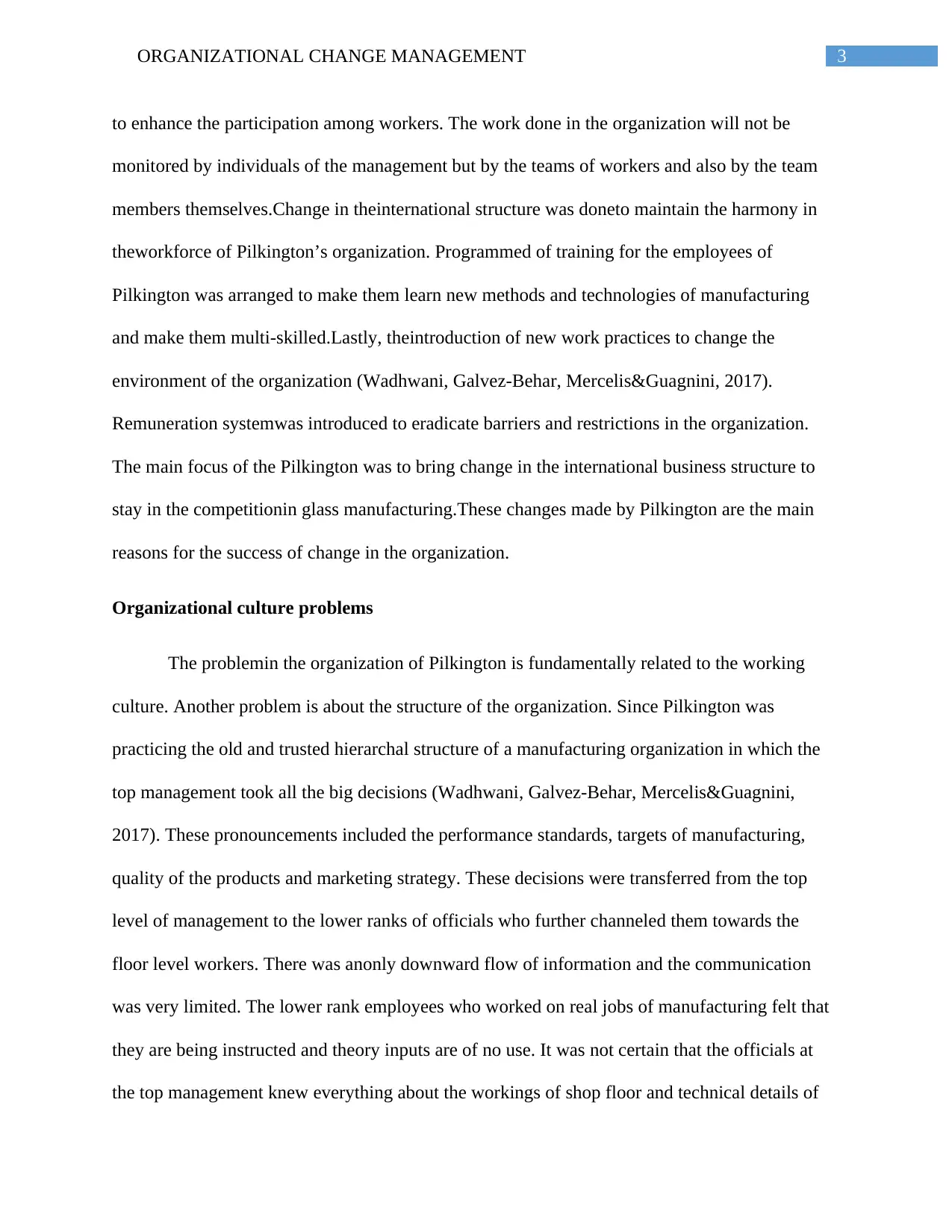
3ORGANIZATIONAL CHANGE MANAGEMENT
to enhance the participation among workers. The work done in the organization will not be
monitored by individuals of the management but by the teams of workers and also by the team
members themselves.Change in theinternational structure was doneto maintain the harmony in
theworkforce of Pilkington’s organization. Programmed of training for the employees of
Pilkington was arranged to make them learn new methods and technologies of manufacturing
and make them multi-skilled.Lastly, theintroduction of new work practices to change the
environment of the organization (Wadhwani, Galvez-Behar, Mercelis&Guagnini, 2017).
Remuneration systemwas introduced to eradicate barriers and restrictions in the organization.
The main focus of the Pilkington was to bring change in the international business structure to
stay in the competitionin glass manufacturing.These changes made by Pilkington are the main
reasons for the success of change in the organization.
Organizational culture problems
The problemin the organization of Pilkington is fundamentally related to the working
culture. Another problem is about the structure of the organization. Since Pilkington was
practicing the old and trusted hierarchal structure of a manufacturing organization in which the
top management took all the big decisions (Wadhwani, Galvez-Behar, Mercelis&Guagnini,
2017). These pronouncements included the performance standards, targets of manufacturing,
quality of the products and marketing strategy. These decisions were transferred from the top
level of management to the lower ranks of officials who further channeled them towards the
floor level workers. There was anonly downward flow of information and the communication
was very limited. The lower rank employees who worked on real jobs of manufacturing felt that
they are being instructed and theory inputs are of no use. It was not certain that the officials at
the top management knew everything about the workings of shop floor and technical details of
to enhance the participation among workers. The work done in the organization will not be
monitored by individuals of the management but by the teams of workers and also by the team
members themselves.Change in theinternational structure was doneto maintain the harmony in
theworkforce of Pilkington’s organization. Programmed of training for the employees of
Pilkington was arranged to make them learn new methods and technologies of manufacturing
and make them multi-skilled.Lastly, theintroduction of new work practices to change the
environment of the organization (Wadhwani, Galvez-Behar, Mercelis&Guagnini, 2017).
Remuneration systemwas introduced to eradicate barriers and restrictions in the organization.
The main focus of the Pilkington was to bring change in the international business structure to
stay in the competitionin glass manufacturing.These changes made by Pilkington are the main
reasons for the success of change in the organization.
Organizational culture problems
The problemin the organization of Pilkington is fundamentally related to the working
culture. Another problem is about the structure of the organization. Since Pilkington was
practicing the old and trusted hierarchal structure of a manufacturing organization in which the
top management took all the big decisions (Wadhwani, Galvez-Behar, Mercelis&Guagnini,
2017). These pronouncements included the performance standards, targets of manufacturing,
quality of the products and marketing strategy. These decisions were transferred from the top
level of management to the lower ranks of officials who further channeled them towards the
floor level workers. There was anonly downward flow of information and the communication
was very limited. The lower rank employees who worked on real jobs of manufacturing felt that
they are being instructed and theory inputs are of no use. It was not certain that the officials at
the top management knew everything about the workings of shop floor and technical details of
Paraphrase This Document
Need a fresh take? Get an instant paraphrase of this document with our AI Paraphraser
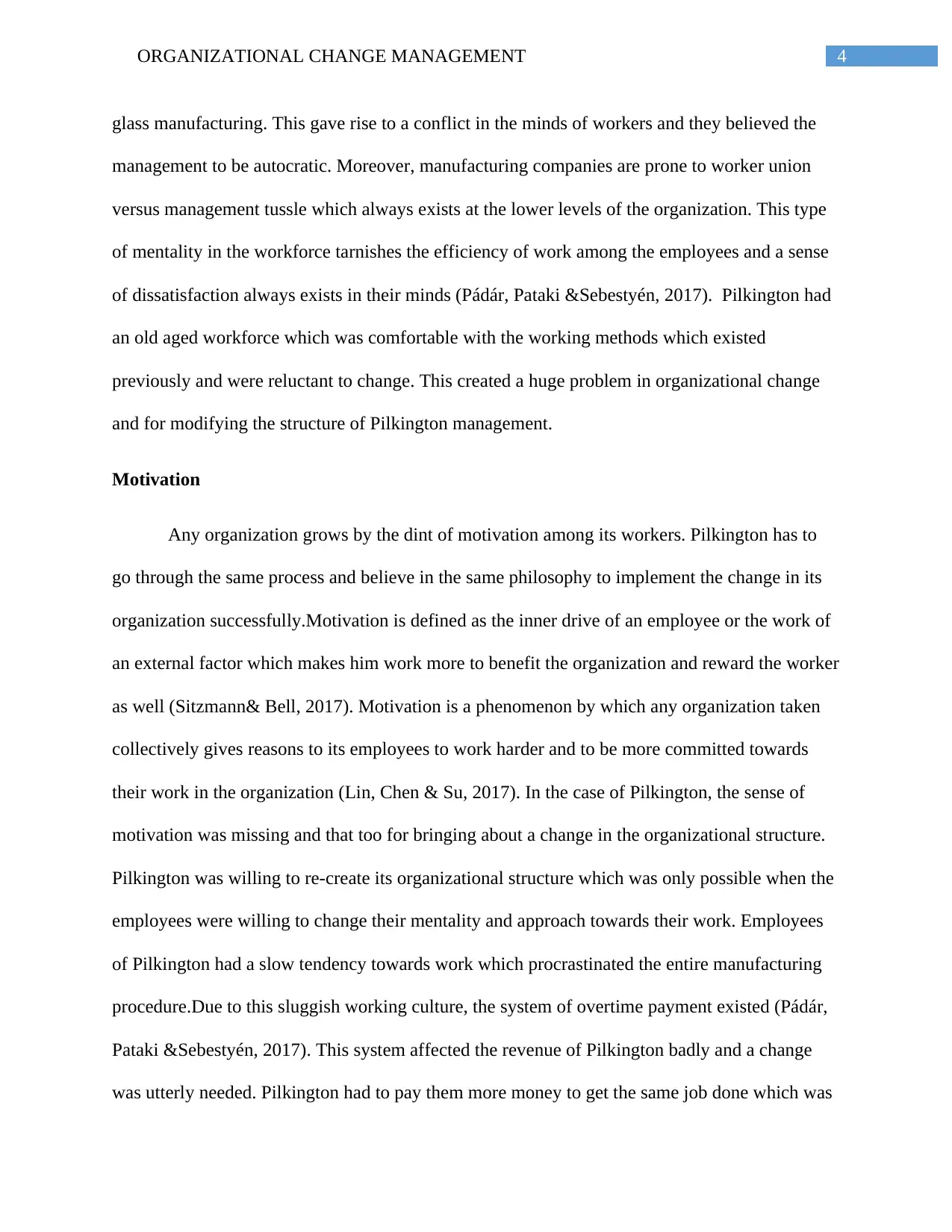
4ORGANIZATIONAL CHANGE MANAGEMENT
glass manufacturing. This gave rise to a conflict in the minds of workers and they believed the
management to be autocratic. Moreover, manufacturing companies are prone to worker union
versus management tussle which always exists at the lower levels of the organization. This type
of mentality in the workforce tarnishes the efficiency of work among the employees and a sense
of dissatisfaction always exists in their minds (Pádár, Pataki &Sebestyén, 2017). Pilkington had
an old aged workforce which was comfortable with the working methods which existed
previously and were reluctant to change. This created a huge problem in organizational change
and for modifying the structure of Pilkington management.
Motivation
Any organization grows by the dint of motivation among its workers. Pilkington has to
go through the same process and believe in the same philosophy to implement the change in its
organization successfully.Motivation is defined as the inner drive of an employee or the work of
an external factor which makes him work more to benefit the organization and reward the worker
as well (Sitzmann& Bell, 2017). Motivation is a phenomenon by which any organization taken
collectively gives reasons to its employees to work harder and to be more committed towards
their work in the organization (Lin, Chen & Su, 2017). In the case of Pilkington, the sense of
motivation was missing and that too for bringing about a change in the organizational structure.
Pilkington was willing to re-create its organizational structure which was only possible when the
employees were willing to change their mentality and approach towards their work. Employees
of Pilkington had a slow tendency towards work which procrastinated the entire manufacturing
procedure.Due to this sluggish working culture, the system of overtime payment existed (Pádár,
Pataki &Sebestyén, 2017). This system affected the revenue of Pilkington badly and a change
was utterly needed. Pilkington had to pay them more money to get the same job done which was
glass manufacturing. This gave rise to a conflict in the minds of workers and they believed the
management to be autocratic. Moreover, manufacturing companies are prone to worker union
versus management tussle which always exists at the lower levels of the organization. This type
of mentality in the workforce tarnishes the efficiency of work among the employees and a sense
of dissatisfaction always exists in their minds (Pádár, Pataki &Sebestyén, 2017). Pilkington had
an old aged workforce which was comfortable with the working methods which existed
previously and were reluctant to change. This created a huge problem in organizational change
and for modifying the structure of Pilkington management.
Motivation
Any organization grows by the dint of motivation among its workers. Pilkington has to
go through the same process and believe in the same philosophy to implement the change in its
organization successfully.Motivation is defined as the inner drive of an employee or the work of
an external factor which makes him work more to benefit the organization and reward the worker
as well (Sitzmann& Bell, 2017). Motivation is a phenomenon by which any organization taken
collectively gives reasons to its employees to work harder and to be more committed towards
their work in the organization (Lin, Chen & Su, 2017). In the case of Pilkington, the sense of
motivation was missing and that too for bringing about a change in the organizational structure.
Pilkington was willing to re-create its organizational structure which was only possible when the
employees were willing to change their mentality and approach towards their work. Employees
of Pilkington had a slow tendency towards work which procrastinated the entire manufacturing
procedure.Due to this sluggish working culture, the system of overtime payment existed (Pádár,
Pataki &Sebestyén, 2017). This system affected the revenue of Pilkington badly and a change
was utterly needed. Pilkington had to pay them more money to get the same job done which was
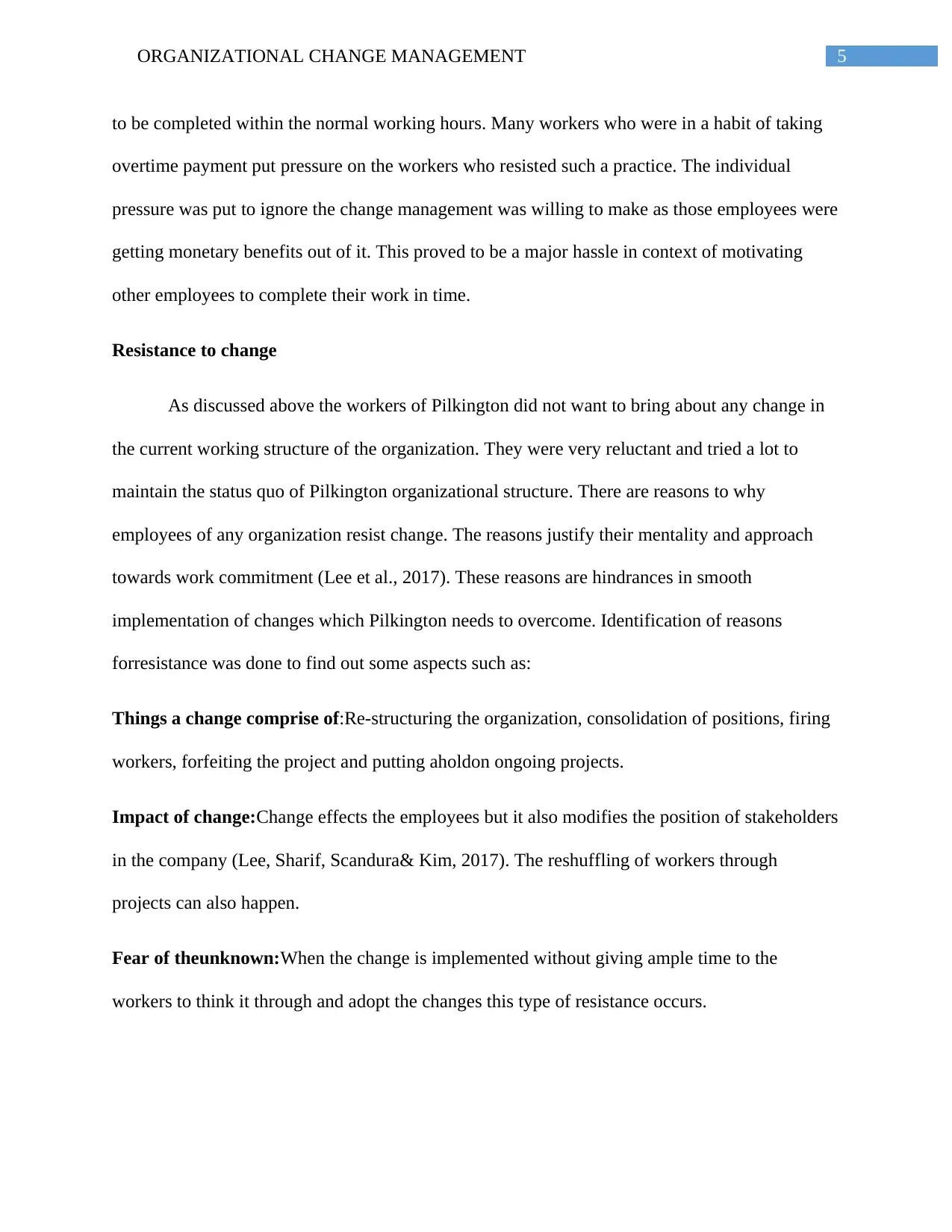
5ORGANIZATIONAL CHANGE MANAGEMENT
to be completed within the normal working hours. Many workers who were in a habit of taking
overtime payment put pressure on the workers who resisted such a practice. The individual
pressure was put to ignore the change management was willing to make as those employees were
getting monetary benefits out of it. This proved to be a major hassle in context of motivating
other employees to complete their work in time.
Resistance to change
As discussed above the workers of Pilkington did not want to bring about any change in
the current working structure of the organization. They were very reluctant and tried a lot to
maintain the status quo of Pilkington organizational structure. There are reasons to why
employees of any organization resist change. The reasons justify their mentality and approach
towards work commitment (Lee et al., 2017). These reasons are hindrances in smooth
implementation of changes which Pilkington needs to overcome. Identification of reasons
forresistance was done to find out some aspects such as:
Things a change comprise of:Re-structuring the organization, consolidation of positions, firing
workers, forfeiting the project and putting aholdon ongoing projects.
Impact of change:Change effects the employees but it also modifies the position of stakeholders
in the company (Lee, Sharif, Scandura& Kim, 2017). The reshuffling of workers through
projects can also happen.
Fear of theunknown:When the change is implemented without giving ample time to the
workers to think it through and adopt the changes this type of resistance occurs.
to be completed within the normal working hours. Many workers who were in a habit of taking
overtime payment put pressure on the workers who resisted such a practice. The individual
pressure was put to ignore the change management was willing to make as those employees were
getting monetary benefits out of it. This proved to be a major hassle in context of motivating
other employees to complete their work in time.
Resistance to change
As discussed above the workers of Pilkington did not want to bring about any change in
the current working structure of the organization. They were very reluctant and tried a lot to
maintain the status quo of Pilkington organizational structure. There are reasons to why
employees of any organization resist change. The reasons justify their mentality and approach
towards work commitment (Lee et al., 2017). These reasons are hindrances in smooth
implementation of changes which Pilkington needs to overcome. Identification of reasons
forresistance was done to find out some aspects such as:
Things a change comprise of:Re-structuring the organization, consolidation of positions, firing
workers, forfeiting the project and putting aholdon ongoing projects.
Impact of change:Change effects the employees but it also modifies the position of stakeholders
in the company (Lee, Sharif, Scandura& Kim, 2017). The reshuffling of workers through
projects can also happen.
Fear of theunknown:When the change is implemented without giving ample time to the
workers to think it through and adopt the changes this type of resistance occurs.
⊘ This is a preview!⊘
Do you want full access?
Subscribe today to unlock all pages.

Trusted by 1+ million students worldwide
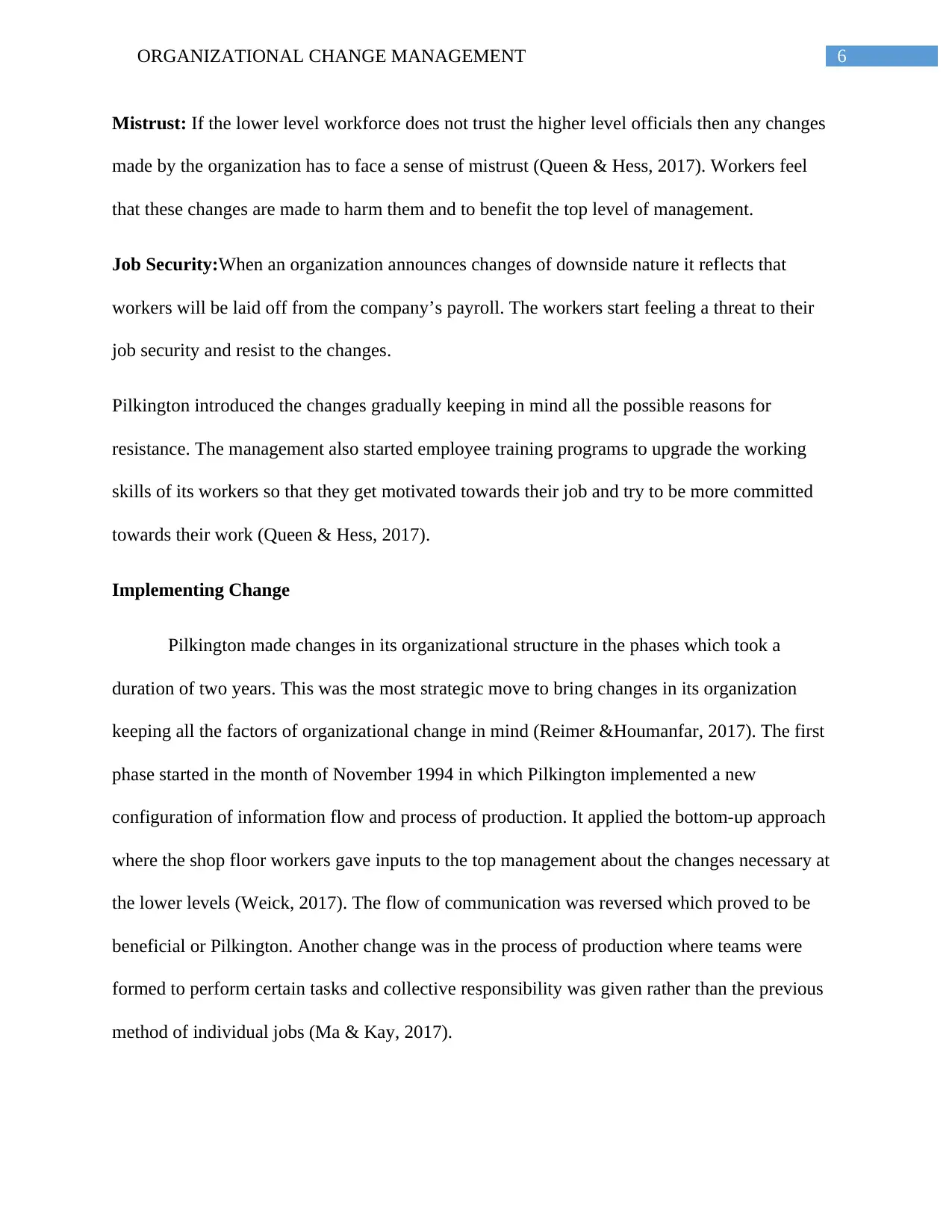
6ORGANIZATIONAL CHANGE MANAGEMENT
Mistrust: If the lower level workforce does not trust the higher level officials then any changes
made by the organization has to face a sense of mistrust (Queen & Hess, 2017). Workers feel
that these changes are made to harm them and to benefit the top level of management.
Job Security:When an organization announces changes of downside nature it reflects that
workers will be laid off from the company’s payroll. The workers start feeling a threat to their
job security and resist to the changes.
Pilkington introduced the changes gradually keeping in mind all the possible reasons for
resistance. The management also started employee training programs to upgrade the working
skills of its workers so that they get motivated towards their job and try to be more committed
towards their work (Queen & Hess, 2017).
Implementing Change
Pilkington made changes in its organizational structure in the phases which took a
duration of two years. This was the most strategic move to bring changes in its organization
keeping all the factors of organizational change in mind (Reimer &Houmanfar, 2017). The first
phase started in the month of November 1994 in which Pilkington implemented a new
configuration of information flow and process of production. It applied the bottom-up approach
where the shop floor workers gave inputs to the top management about the changes necessary at
the lower levels (Weick, 2017). The flow of communication was reversed which proved to be
beneficial or Pilkington. Another change was in the process of production where teams were
formed to perform certain tasks and collective responsibility was given rather than the previous
method of individual jobs (Ma & Kay, 2017).
Mistrust: If the lower level workforce does not trust the higher level officials then any changes
made by the organization has to face a sense of mistrust (Queen & Hess, 2017). Workers feel
that these changes are made to harm them and to benefit the top level of management.
Job Security:When an organization announces changes of downside nature it reflects that
workers will be laid off from the company’s payroll. The workers start feeling a threat to their
job security and resist to the changes.
Pilkington introduced the changes gradually keeping in mind all the possible reasons for
resistance. The management also started employee training programs to upgrade the working
skills of its workers so that they get motivated towards their job and try to be more committed
towards their work (Queen & Hess, 2017).
Implementing Change
Pilkington made changes in its organizational structure in the phases which took a
duration of two years. This was the most strategic move to bring changes in its organization
keeping all the factors of organizational change in mind (Reimer &Houmanfar, 2017). The first
phase started in the month of November 1994 in which Pilkington implemented a new
configuration of information flow and process of production. It applied the bottom-up approach
where the shop floor workers gave inputs to the top management about the changes necessary at
the lower levels (Weick, 2017). The flow of communication was reversed which proved to be
beneficial or Pilkington. Another change was in the process of production where teams were
formed to perform certain tasks and collective responsibility was given rather than the previous
method of individual jobs (Ma & Kay, 2017).
Paraphrase This Document
Need a fresh take? Get an instant paraphrase of this document with our AI Paraphraser
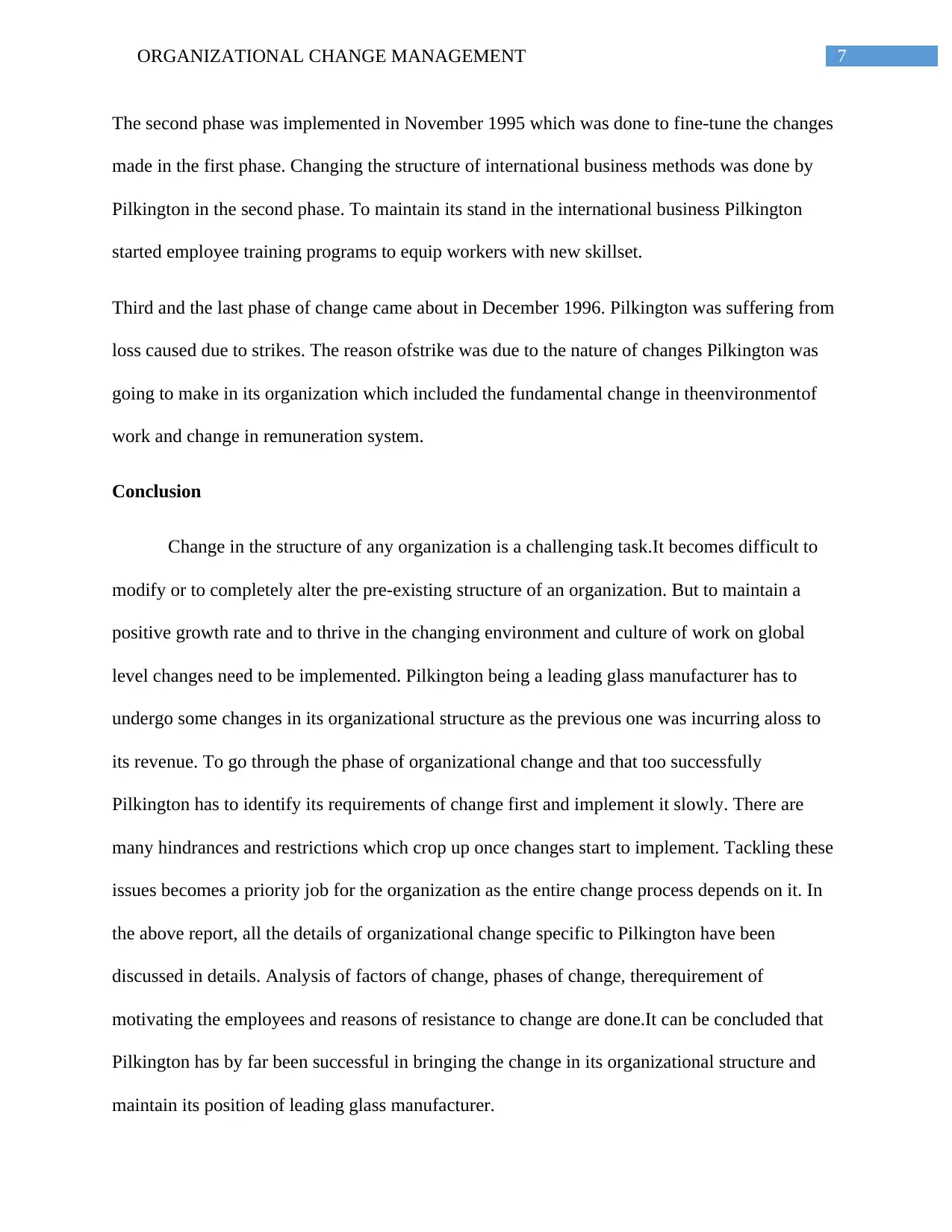
7ORGANIZATIONAL CHANGE MANAGEMENT
The second phase was implemented in November 1995 which was done to fine-tune the changes
made in the first phase. Changing the structure of international business methods was done by
Pilkington in the second phase. To maintain its stand in the international business Pilkington
started employee training programs to equip workers with new skillset.
Third and the last phase of change came about in December 1996. Pilkington was suffering from
loss caused due to strikes. The reason ofstrike was due to the nature of changes Pilkington was
going to make in its organization which included the fundamental change in theenvironmentof
work and change in remuneration system.
Conclusion
Change in the structure of any organization is a challenging task.It becomes difficult to
modify or to completely alter the pre-existing structure of an organization. But to maintain a
positive growth rate and to thrive in the changing environment and culture of work on global
level changes need to be implemented. Pilkington being a leading glass manufacturer has to
undergo some changes in its organizational structure as the previous one was incurring aloss to
its revenue. To go through the phase of organizational change and that too successfully
Pilkington has to identify its requirements of change first and implement it slowly. There are
many hindrances and restrictions which crop up once changes start to implement. Tackling these
issues becomes a priority job for the organization as the entire change process depends on it. In
the above report, all the details of organizational change specific to Pilkington have been
discussed in details. Analysis of factors of change, phases of change, therequirement of
motivating the employees and reasons of resistance to change are done.It can be concluded that
Pilkington has by far been successful in bringing the change in its organizational structure and
maintain its position of leading glass manufacturer.
The second phase was implemented in November 1995 which was done to fine-tune the changes
made in the first phase. Changing the structure of international business methods was done by
Pilkington in the second phase. To maintain its stand in the international business Pilkington
started employee training programs to equip workers with new skillset.
Third and the last phase of change came about in December 1996. Pilkington was suffering from
loss caused due to strikes. The reason ofstrike was due to the nature of changes Pilkington was
going to make in its organization which included the fundamental change in theenvironmentof
work and change in remuneration system.
Conclusion
Change in the structure of any organization is a challenging task.It becomes difficult to
modify or to completely alter the pre-existing structure of an organization. But to maintain a
positive growth rate and to thrive in the changing environment and culture of work on global
level changes need to be implemented. Pilkington being a leading glass manufacturer has to
undergo some changes in its organizational structure as the previous one was incurring aloss to
its revenue. To go through the phase of organizational change and that too successfully
Pilkington has to identify its requirements of change first and implement it slowly. There are
many hindrances and restrictions which crop up once changes start to implement. Tackling these
issues becomes a priority job for the organization as the entire change process depends on it. In
the above report, all the details of organizational change specific to Pilkington have been
discussed in details. Analysis of factors of change, phases of change, therequirement of
motivating the employees and reasons of resistance to change are done.It can be concluded that
Pilkington has by far been successful in bringing the change in its organizational structure and
maintain its position of leading glass manufacturer.
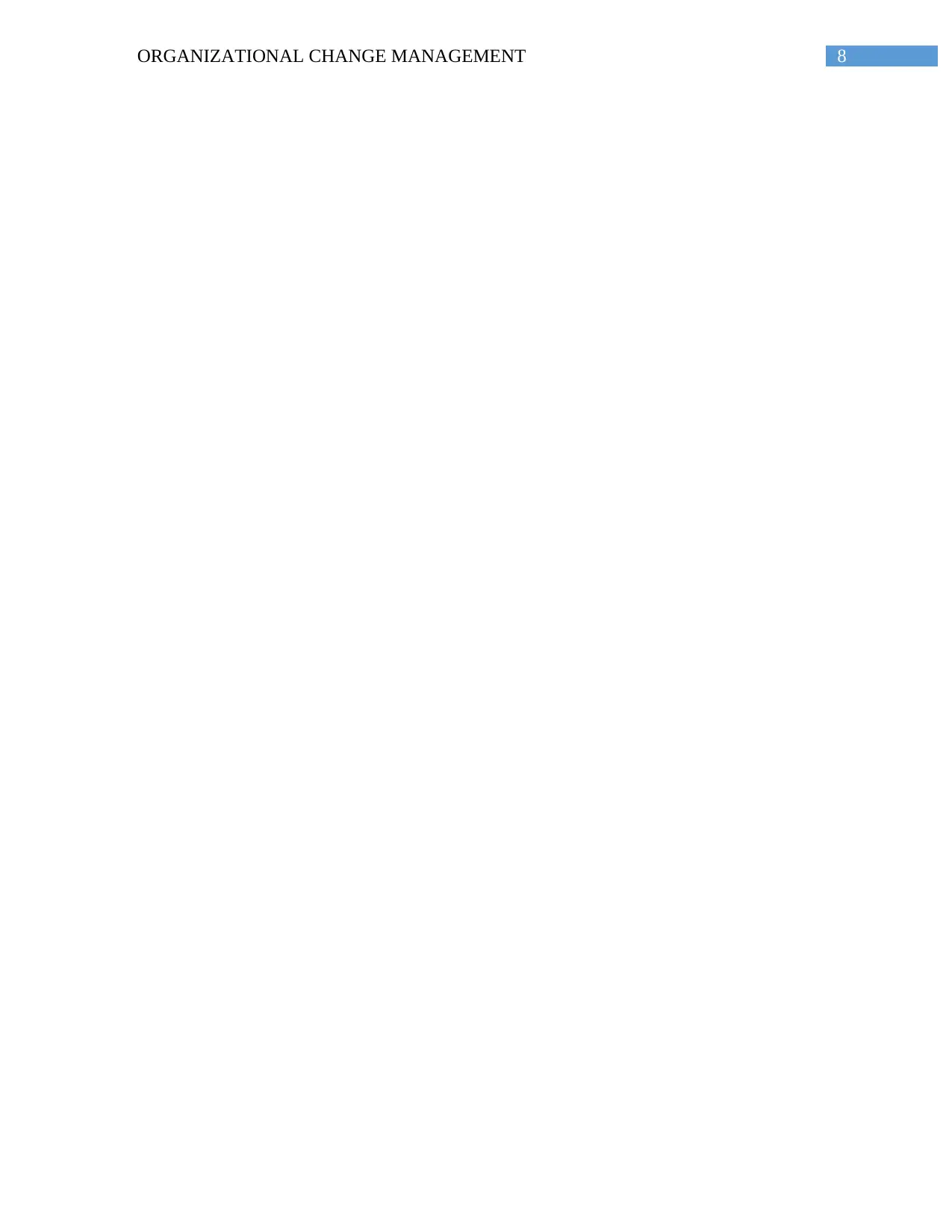
8ORGANIZATIONAL CHANGE MANAGEMENT
⊘ This is a preview!⊘
Do you want full access?
Subscribe today to unlock all pages.

Trusted by 1+ million students worldwide
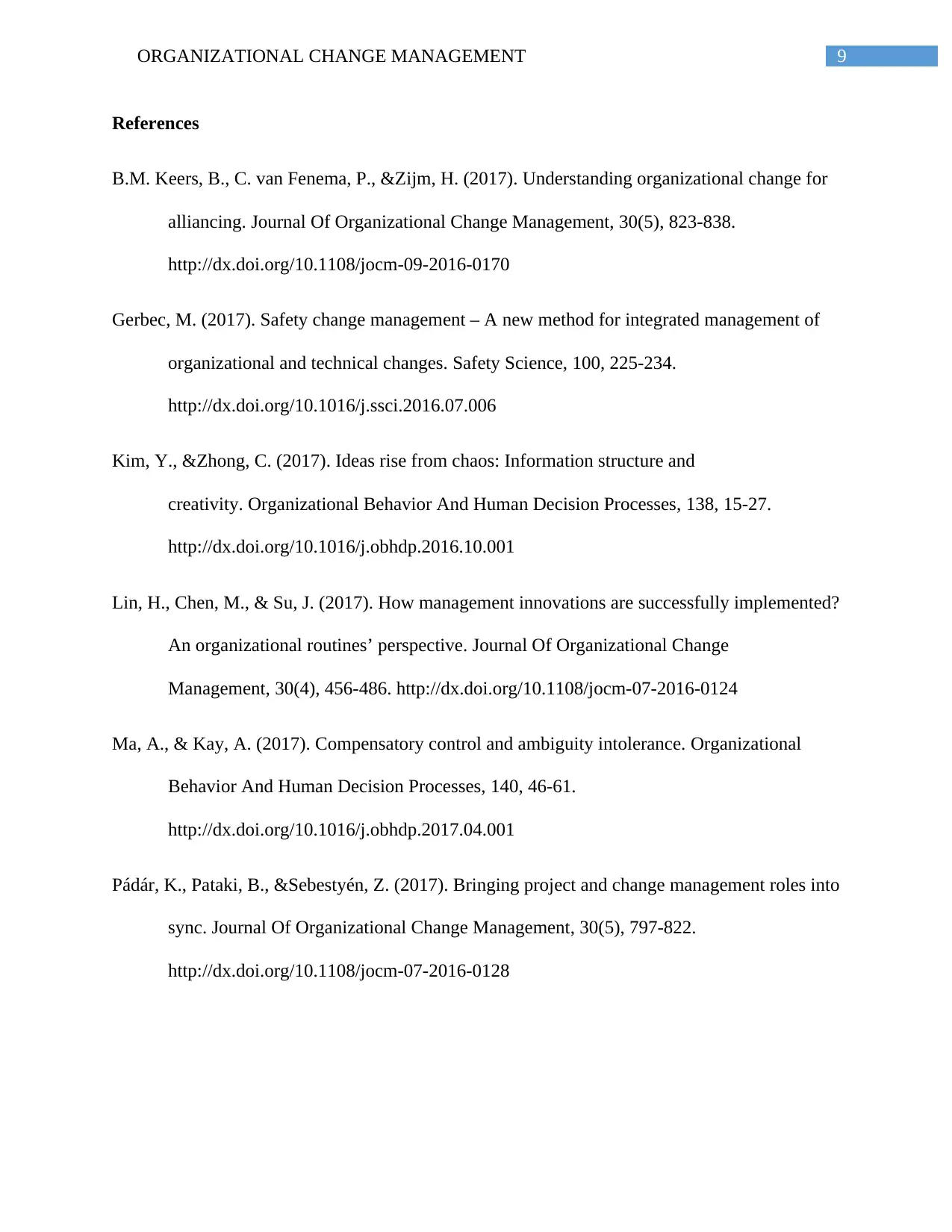
9ORGANIZATIONAL CHANGE MANAGEMENT
References
B.M. Keers, B., C. van Fenema, P., &Zijm, H. (2017). Understanding organizational change for
alliancing. Journal Of Organizational Change Management, 30(5), 823-838.
http://dx.doi.org/10.1108/jocm-09-2016-0170
Gerbec, M. (2017). Safety change management – A new method for integrated management of
organizational and technical changes. Safety Science, 100, 225-234.
http://dx.doi.org/10.1016/j.ssci.2016.07.006
Kim, Y., &Zhong, C. (2017). Ideas rise from chaos: Information structure and
creativity. Organizational Behavior And Human Decision Processes, 138, 15-27.
http://dx.doi.org/10.1016/j.obhdp.2016.10.001
Lin, H., Chen, M., & Su, J. (2017). How management innovations are successfully implemented?
An organizational routines’ perspective. Journal Of Organizational Change
Management, 30(4), 456-486. http://dx.doi.org/10.1108/jocm-07-2016-0124
Ma, A., & Kay, A. (2017). Compensatory control and ambiguity intolerance. Organizational
Behavior And Human Decision Processes, 140, 46-61.
http://dx.doi.org/10.1016/j.obhdp.2017.04.001
Pádár, K., Pataki, B., &Sebestyén, Z. (2017). Bringing project and change management roles into
sync. Journal Of Organizational Change Management, 30(5), 797-822.
http://dx.doi.org/10.1108/jocm-07-2016-0128
References
B.M. Keers, B., C. van Fenema, P., &Zijm, H. (2017). Understanding organizational change for
alliancing. Journal Of Organizational Change Management, 30(5), 823-838.
http://dx.doi.org/10.1108/jocm-09-2016-0170
Gerbec, M. (2017). Safety change management – A new method for integrated management of
organizational and technical changes. Safety Science, 100, 225-234.
http://dx.doi.org/10.1016/j.ssci.2016.07.006
Kim, Y., &Zhong, C. (2017). Ideas rise from chaos: Information structure and
creativity. Organizational Behavior And Human Decision Processes, 138, 15-27.
http://dx.doi.org/10.1016/j.obhdp.2016.10.001
Lin, H., Chen, M., & Su, J. (2017). How management innovations are successfully implemented?
An organizational routines’ perspective. Journal Of Organizational Change
Management, 30(4), 456-486. http://dx.doi.org/10.1108/jocm-07-2016-0124
Ma, A., & Kay, A. (2017). Compensatory control and ambiguity intolerance. Organizational
Behavior And Human Decision Processes, 140, 46-61.
http://dx.doi.org/10.1016/j.obhdp.2017.04.001
Pádár, K., Pataki, B., &Sebestyén, Z. (2017). Bringing project and change management roles into
sync. Journal Of Organizational Change Management, 30(5), 797-822.
http://dx.doi.org/10.1108/jocm-07-2016-0128
Paraphrase This Document
Need a fresh take? Get an instant paraphrase of this document with our AI Paraphraser
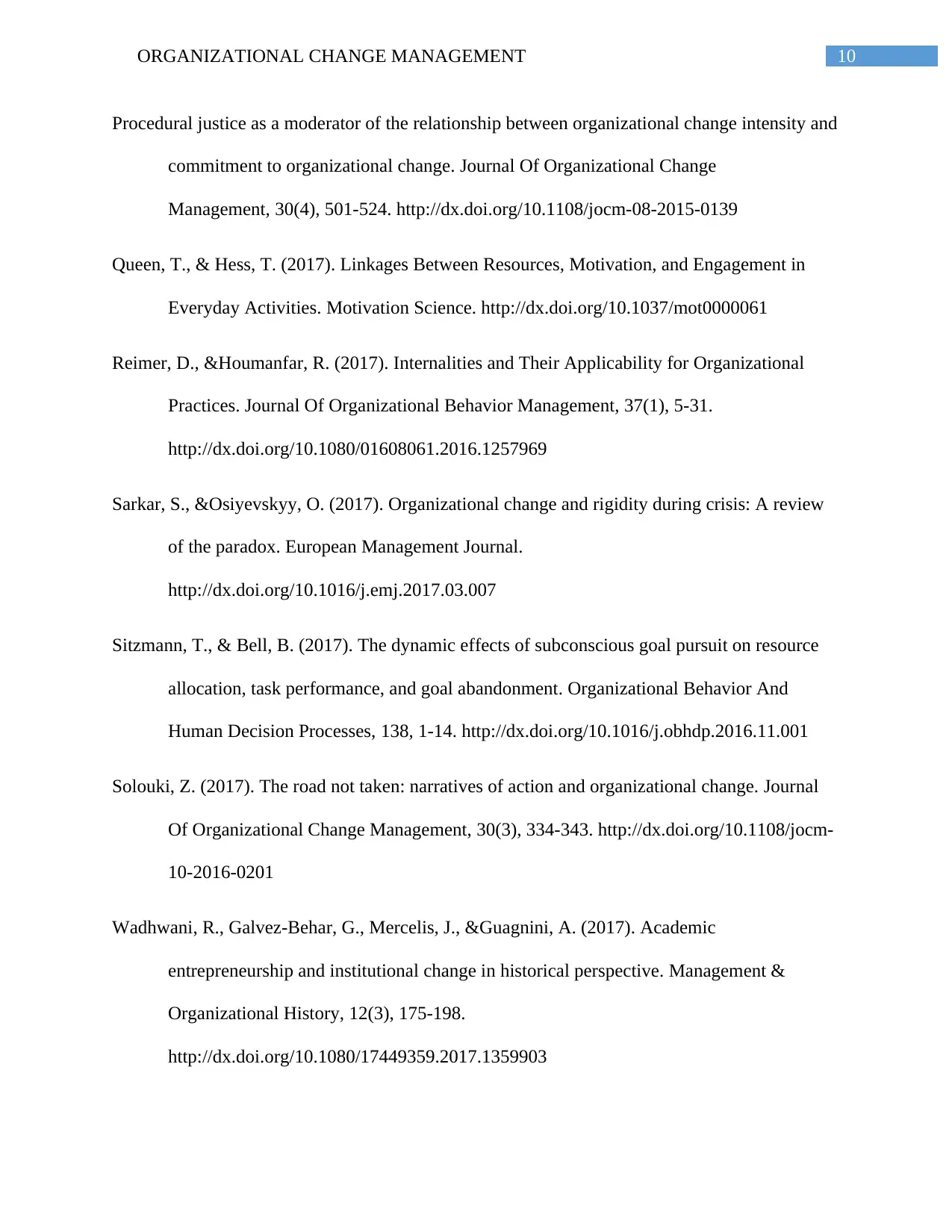
10ORGANIZATIONAL CHANGE MANAGEMENT
Procedural justice as a moderator of the relationship between organizational change intensity and
commitment to organizational change. Journal Of Organizational Change
Management, 30(4), 501-524. http://dx.doi.org/10.1108/jocm-08-2015-0139
Queen, T., & Hess, T. (2017). Linkages Between Resources, Motivation, and Engagement in
Everyday Activities. Motivation Science. http://dx.doi.org/10.1037/mot0000061
Reimer, D., &Houmanfar, R. (2017). Internalities and Their Applicability for Organizational
Practices. Journal Of Organizational Behavior Management, 37(1), 5-31.
http://dx.doi.org/10.1080/01608061.2016.1257969
Sarkar, S., &Osiyevskyy, O. (2017). Organizational change and rigidity during crisis: A review
of the paradox. European Management Journal.
http://dx.doi.org/10.1016/j.emj.2017.03.007
Sitzmann, T., & Bell, B. (2017). The dynamic effects of subconscious goal pursuit on resource
allocation, task performance, and goal abandonment. Organizational Behavior And
Human Decision Processes, 138, 1-14. http://dx.doi.org/10.1016/j.obhdp.2016.11.001
Solouki, Z. (2017). The road not taken: narratives of action and organizational change. Journal
Of Organizational Change Management, 30(3), 334-343. http://dx.doi.org/10.1108/jocm-
10-2016-0201
Wadhwani, R., Galvez-Behar, G., Mercelis, J., &Guagnini, A. (2017). Academic
entrepreneurship and institutional change in historical perspective. Management &
Organizational History, 12(3), 175-198.
http://dx.doi.org/10.1080/17449359.2017.1359903
Procedural justice as a moderator of the relationship between organizational change intensity and
commitment to organizational change. Journal Of Organizational Change
Management, 30(4), 501-524. http://dx.doi.org/10.1108/jocm-08-2015-0139
Queen, T., & Hess, T. (2017). Linkages Between Resources, Motivation, and Engagement in
Everyday Activities. Motivation Science. http://dx.doi.org/10.1037/mot0000061
Reimer, D., &Houmanfar, R. (2017). Internalities and Their Applicability for Organizational
Practices. Journal Of Organizational Behavior Management, 37(1), 5-31.
http://dx.doi.org/10.1080/01608061.2016.1257969
Sarkar, S., &Osiyevskyy, O. (2017). Organizational change and rigidity during crisis: A review
of the paradox. European Management Journal.
http://dx.doi.org/10.1016/j.emj.2017.03.007
Sitzmann, T., & Bell, B. (2017). The dynamic effects of subconscious goal pursuit on resource
allocation, task performance, and goal abandonment. Organizational Behavior And
Human Decision Processes, 138, 1-14. http://dx.doi.org/10.1016/j.obhdp.2016.11.001
Solouki, Z. (2017). The road not taken: narratives of action and organizational change. Journal
Of Organizational Change Management, 30(3), 334-343. http://dx.doi.org/10.1108/jocm-
10-2016-0201
Wadhwani, R., Galvez-Behar, G., Mercelis, J., &Guagnini, A. (2017). Academic
entrepreneurship and institutional change in historical perspective. Management &
Organizational History, 12(3), 175-198.
http://dx.doi.org/10.1080/17449359.2017.1359903

11ORGANIZATIONAL CHANGE MANAGEMENT
Weick, K. (2017). Perspective Construction in Organizational Behavior. Annual Review Of
Organizational Psychology And Organizational Behavior, 4(1), 1-17.
http://dx.doi.org/10.1146/annurev-orgpsych-032516-113043
Weick, K. (2017). Perspective Construction in Organizational Behavior. Annual Review Of
Organizational Psychology And Organizational Behavior, 4(1), 1-17.
http://dx.doi.org/10.1146/annurev-orgpsych-032516-113043
⊘ This is a preview!⊘
Do you want full access?
Subscribe today to unlock all pages.

Trusted by 1+ million students worldwide
1 out of 12
Related Documents
Your All-in-One AI-Powered Toolkit for Academic Success.
+13062052269
info@desklib.com
Available 24*7 on WhatsApp / Email
![[object Object]](/_next/static/media/star-bottom.7253800d.svg)
Unlock your academic potential
Copyright © 2020–2025 A2Z Services. All Rights Reserved. Developed and managed by ZUCOL.



